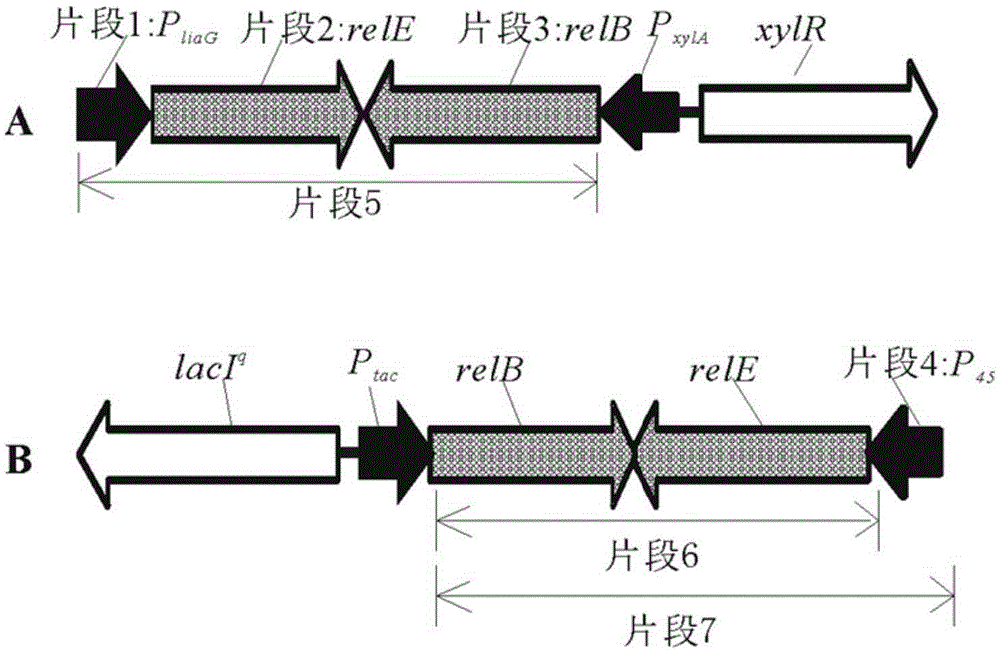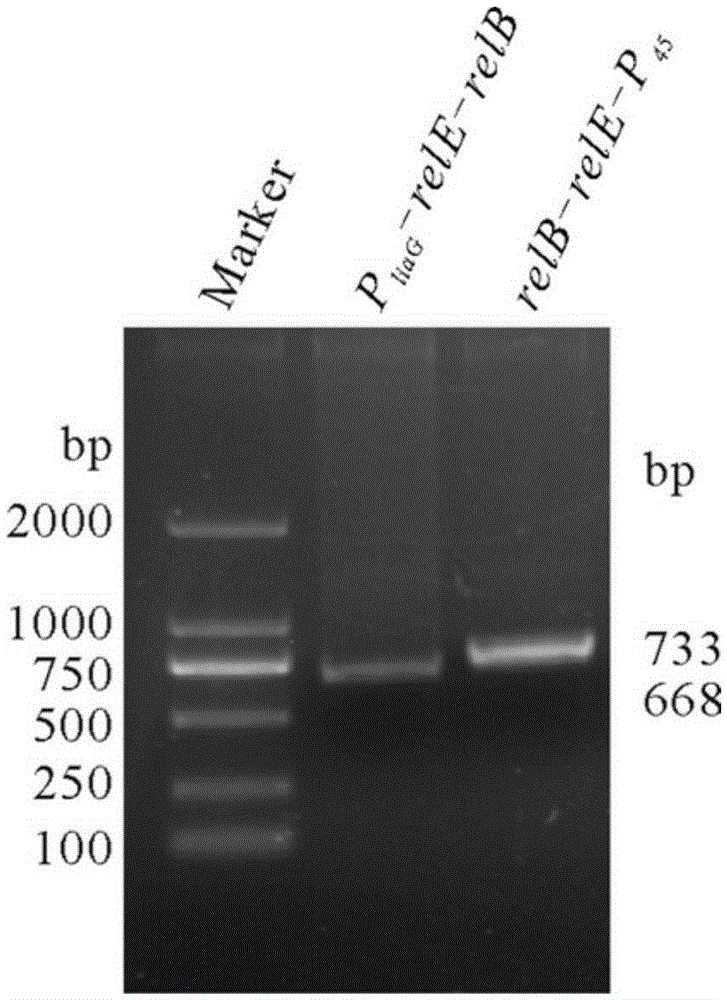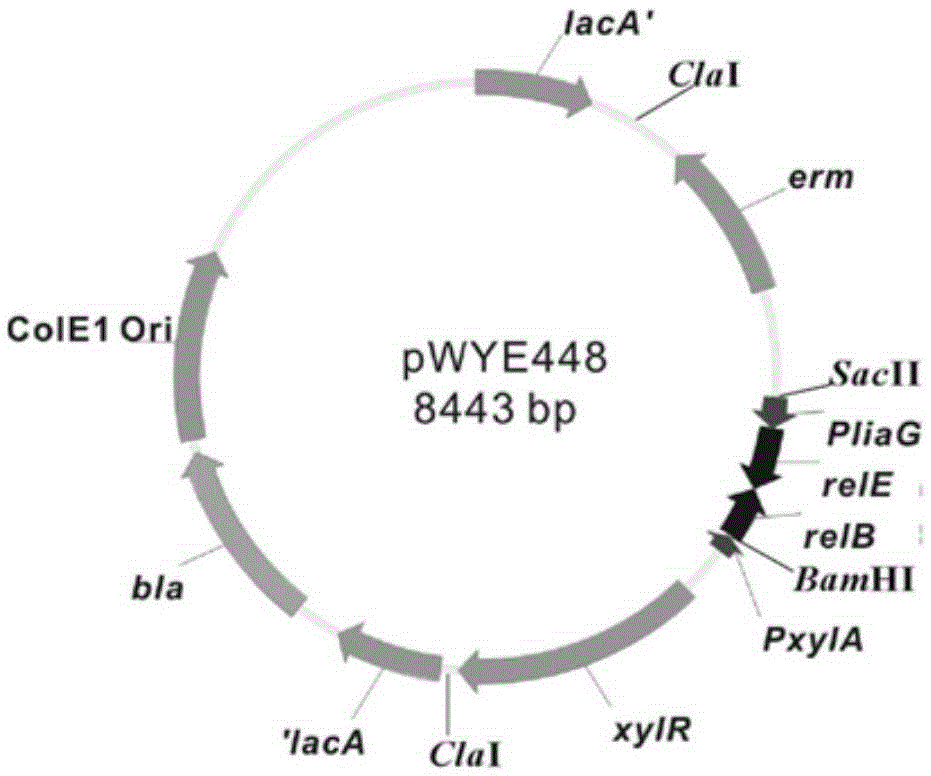Bacterial traceless genetic manipulation vector and construction method and application thereof
A carrier and bacterial technology, applied in the field of bacterial traceless genetic manipulation carrier and its construction, can solve the problems of difficult screening, low specificity of genetic operating system, unstable system, etc., and achieve the effect of high-efficiency use
- Summary
- Abstract
- Description
- Claims
- Application Information
AI Technical Summary
Problems solved by technology
Method used
Image
Examples
Embodiment 1
[0091] The construction of the toxin anti-screening element (TCCRAS) controlled by the anti-toxin switch of embodiment 1
[0092] (1) Gene amplification
[0093] The genomic DNA of Bacillus subtilis W168 (purchased from Bacillus Genetic Stock Center, USA, catalog number 1A308) was used as template and P1 / P2 were used as primers to amplify P liaG Promoter gene (fragment 1, figure 1 , SEQ ID NO: 3); Escherichia coli W3110 (purchased from the U.S. Coli Genetic Stock Center, item number 4474) genomic DNA was used as a template, and P3 / P4 was used as a primer to amplify the toxin protein relE gene (fragment 2, figure 1 , SEQ ID NO: 1); With Escherichia coli W3110 genomic DNA as template, P5 / P6 is primer amplification antitoxin protein relB gene (fragment 3, figure 1 , SEQ ID NO: 2); with Corynebacterium glutamicum ATCC13032 (purchased from the American Type Microorganism Collection ATCC, article number 534) genomic DNA as template, P9 / P10 as primer amplification P 45 Promoter ge...
Embodiment 2
[0112]Example 2 Verification of the validity of the toxin anti-screening element TCCRAS controlled by the anti-toxin switch as an anti-screening marker
[0113] (1) Validation of TCCRAS in Bacillus subtilis
[0114] The plasmid pAX01 and the above-mentioned recombinant plasmid pWYE448 were respectively transformed into Bacillus subtilis W168 natural competent cells, and the obtained recombinant strain BS048 (W168ΔlacA::P xylA -erm) and BS084 (W168ΔlacA::P liaG -relE-P xylA -relB-erm). Strains BS048 and BS084 were streaked on MLS (0.5 μg / mL erythromycin + 12.5 μg / mL lincomycin) plates with and without xylose, respectively, to detect the toxicity of the toxin protein RelE bacillus. The result shows that BS084 bacterial strain can grow on the MLS plate that adds 1% xylose, can't grow on the plate that does not contain xylose ( Figure 5 ). Therefore, expressing the toxin protein encoding gene relE alone in Bacillus subtilis can inhibit the growth of the strain, and TCCRAS ca...
Embodiment 3
[0117] Embodiment 3 utilizes TCCRAS to construct the traceless genetic manipulation vector of Bacillus subtilis
[0118] (1) Gene amplification
[0119] Using Bacillus subtilis W168 genomic DNA as a template, using P11 / P12 as primers to amplify the upstream homology arm of the amylase gene amyE, the size is 516bp; using P13 / P14 as primers to amplify the downstream homology arm of the amylase gene amyE, The size is 766bp. After the PCR amplification, the above two PCR products were recovered by agarose gel, and the recovered DNA product was used as a template for SOE-PCR reaction, and the obtained PCR fragment was recovered by agarose gel, and the common PCR Taq The enzyme adds A to its terminus.
[0120] (2) Connection, transformation and PCR verification
[0121] The DNA fragment after the A addition reaction in step (1) was purified, and ligated with pMD19T-simple vector (purchased from Treasure Bioengineering (Dalian) Co., Ltd., China, Cat. No. 6013). Using CaCl 2 Esch...
PUM
 Login to View More
Login to View More Abstract
Description
Claims
Application Information
 Login to View More
Login to View More - R&D
- Intellectual Property
- Life Sciences
- Materials
- Tech Scout
- Unparalleled Data Quality
- Higher Quality Content
- 60% Fewer Hallucinations
Browse by: Latest US Patents, China's latest patents, Technical Efficacy Thesaurus, Application Domain, Technology Topic, Popular Technical Reports.
© 2025 PatSnap. All rights reserved.Legal|Privacy policy|Modern Slavery Act Transparency Statement|Sitemap|About US| Contact US: help@patsnap.com



